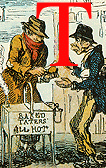The following passage comes from Warner's review of two books — Philip Pullman's Grimm tales for Old and Young and The Fairies Return, a collection of essays — in the Times Literary Supplement for November 16, 2012. As she reminds us, the brothers Grimm intended to produce, not a book for children, but a nationalistic and “pioneering attempt at popular ethnography, around thirty years before the word "folklore" was introduced into English” (9). — George P. Landow.

he Grimms called what they were looking for "Folk Poesy", and they stipulated that its origins must be unadulterated: "Above all", Jacob wrote, "it is important that these items should be gathered faithfully and truly, without decoration and addition and with the greatest possible precision and detail, from the mouths of the story-tellers, where practicable in and with their own authentic words." The Brothers's impulse was philological and lexicographical, and in 1812 Children's and Household Tales came out in an edition of 600 with an apparatus of notes running to hundreds of pages. It was not intended to be read for pleasure by the subjects of its title; it was a learned work setting out to unearth an alternative native canon, reconfigure the cultural history of Germany along lines that would distinguish its special qualities and emancipate it from the monopoly of classical and French superiority. As Jack Zipes has shown in The Irrestible Fairy Tale, the Grimms' Tales were only repackaged for the general book trade and family entertainment by the Brothers after they received, much to their astonishment, Taylor's first English translation (1823) with its jolly, child-friendly illustrations by the the caricaturist George Cruikshank. [emphasis added]

Bibliography
Warner, Marina. “Toads, Tongues and Roses.” Times Literary Supplement (November 16, 2012): 9-11.
Last modified 12 March 2014